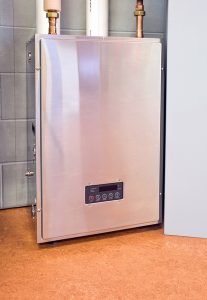Switching from traditional storage tank water heaters to tankless water heaters can be a game-changer for a home’s energy efficiency and convenience. At Temprite Climate Solutions, we understand that this transition might seem daunting, but we’re here to demystify the process for you.
In this post, we’ll walk you through what’s necessary for installing a tankless water heater, the changes that may need to be made, and what you can expect as a consumer from making this shift.
Understanding Tankless Water Heaters
Tankless water heaters, also known as on-demand water heaters, heat water only when you need it, rather than storing hot water in a tank. This leads to significant energy savings and an endless supply of hot water. However, the installation process for a tankless water heater is quite different from that of a traditional storage tank water heater.
What’s Necessary for Installing a Tankless Water Heater
Assessment and Planning
Before installation, a thorough assessment of your home’s plumbing and electrical systems is essential. This includes determining the best location for the unit, which should be easily accessible for maintenance and close to the points of use to minimize heat loss.
Proper Sizing
Choosing the right size of a tankless water heater is crucial. The size depends on the number of appliances that will need hot water simultaneously and the climate of your area. We conduct a detailed analysis to ensure you get a unit that meets your household’s hot water demands efficiently.
Gas Line Upgrades
Tankless water heaters require a substantial gas line; your home must have a gas line that can handle the increased demand. This might mean upgrading your existing gas line.
Ventilation Requirements
Proper ventilation is essential for gas-powered tankless water heaters. These units produce exhaust gases that need to be vented outside. This might require new vent pipes and careful planning to ensure they are safely installed to prevent any risk of carbon monoxide buildup.
Plumbing Adjustments
Connecting a tankless water heater to your existing plumbing system involves precise modifications. This might include new water lines and ensuring proper insulation to maintain water temperature and efficiency and the addition of water filtration to protect the new unit.
What to Expect as a Consumer
Initial Costs
While the upfront cost of a tankless water heater is higher than that of a traditional unit, it’s important to consider the long-term savings. Tankless water heaters are more energy-efficient, leading to lower utility bills. Additionally, their longer lifespan compared to traditional water heaters makes them a cost-effective investment over time.
Energy Efficiency
Tankless water heaters are highly efficient, often achieving energy efficiency ratings of over 90%. This means you’ll be using less energy to heat your water, which is not only good for your wallet but also for the environment.
Unlimited Hot Water
One of the biggest advantages of a tankless water heater is the continuous supply of hot water. You won’t have to worry about running out of hot water during long showers.
Space Savings
The compact size of tankless water heaters frees up valuable space in your home. This can be particularly beneficial in smaller homes or apartments where space is at a premium.
We’re dedicated to making the installation process as smooth and straightforward as possible. By understanding what’s involved and what changes may be needed, you can make an informed decision and enjoy the many advantages that a tankless water heater has to offer. We also handle other tankless water heater services, such as tankless water heater repair in Parksville.

